DermAlert is a personalized web-based repository that helps sufferers of skin sensitivities identify and avoid allergens in skincare product ingredients by offering tailored search results based on their unique sensitivities and patch test findings.
The case study slide deck can be viewed here.

Individuals with skin sensitivities often have problems effectively avoiding allergens and irritants in everyday skincare products, with many receiving insufficient support from their dermatologists following their patch tests. Current platforms do not adequately address the challenges patients face.
Problem 1: The names of allergens on patch tests rarely match their names on ingredient lists. For example, wool alcohols ointment, which is the name found in standard North American patch tests, can be found in ingredient lists under any of these names (and more!):
- Lanolin alcohol
- Lanae alcohol
- Alcoholes lanae
- Wool alcohol
- Cetyl alcohol
- Stearyl alcohol
- Cetylstearyl alcohol
- Cetearyl alcohol
- EINECS-430-1
Problem 2: Current platforms require users to manually input ingredients to filter. During the user research stage, many users reported difficulties inputting their allergens into current filtering platforms. Moreover, 80% of respondents stated that a system that lets them upload their patch test results would be helpful. However, this feature is missing from all current platforms.
Problem 3: Other platforms don’t have a comprehensive inventory of products, focusing only on cosmetics. Respondents also reported difficulty finding many products, especially non-cosmetic ones—including drugs like topical corticosteroids, suncreen, and insect repellent—on currently available filtering platforms.
White Paper Research: I started off looking at research articles on the topic of skin sensitivities, searching keywords such as patch test*, eczema, dermatitis, etc. The goal was to better understand the state of patch testing in NA and what systems/standards currently exist for patients with dermatitis and other skin conditions. My most relevant findings are summarized below:
- Patients who received more support following their patch tests experienced better outcomes than those who received less support.⁹
- Patch tests administered by dermatologists are standardized into series, of which there are 33 available.⁴
- A thorough follow-up review is recommended by experts.⁴
“Proper patient education and instructions on allergen avoidance is essential after patch testing. Adequate time should be spent discussing specific management plans for patch test-positive patients.⁴”
User Interviews: I decided to conduct interviews and surveys (both of which consisted of similar questions) with five individuals suffering some form of allergy-based skin condition and had undergone a patch test.
- On a scale of 0 (no difficulty) to 10, how difficult is it for you to find skincare products that don’t trigger your skin?
- Do you feel like you received sufficient guidance/support following your patch test regarding how to interpret your results and avoid allergens?
- Are you aware of any platforms you can use to filter out allergens in your skincare products?
- If such a platform existed, what format would be easiest for you to use, and what format would you use the most?
- If such a platform existed, what features do you feel would most optimize your experience?
80% of interviewees felt they had received insufficient guidance regarding how to avoid their allergens. Moreover, 100% of respondents reported difficulty in finding skincare products that suited their allergens.
Competitive Analysis: The competitive platforms claim to help users avoid allergens in skincare products and/or are resources provided to patients after patch tests.

- None of the competitors accounted for differing names on ingredient lists, requiring users to input multiple filter terms for the same allergen to generate an effective search.
- No platforms had an option for users to upload their patch test results, despite this being a plus for most interviewees.
- All the competitors focused on cosmetic skincare products, and did not include commonly used non-cosmetic products that can also trigger reactions in users.
While some platforms exist that can filter skincare product searches by ingredient, they all lacked features deemed by respondents to be important for an optimal user experience.
I laid out the ideas I had gathered in my research, looking for trends and themes that could help me organize and synthesize my findings and create actionable next steps.

To better understand the goals and behaviours of my target audience, I also created two user personas using demographic and descriptive data from my research stage, including user interviews.


Using what I learned from the analysis stage, I tried working out the process users would take while navigating through the resource. Many of the features were taken from the analysis stage, while others were brought up as solutions to problems.
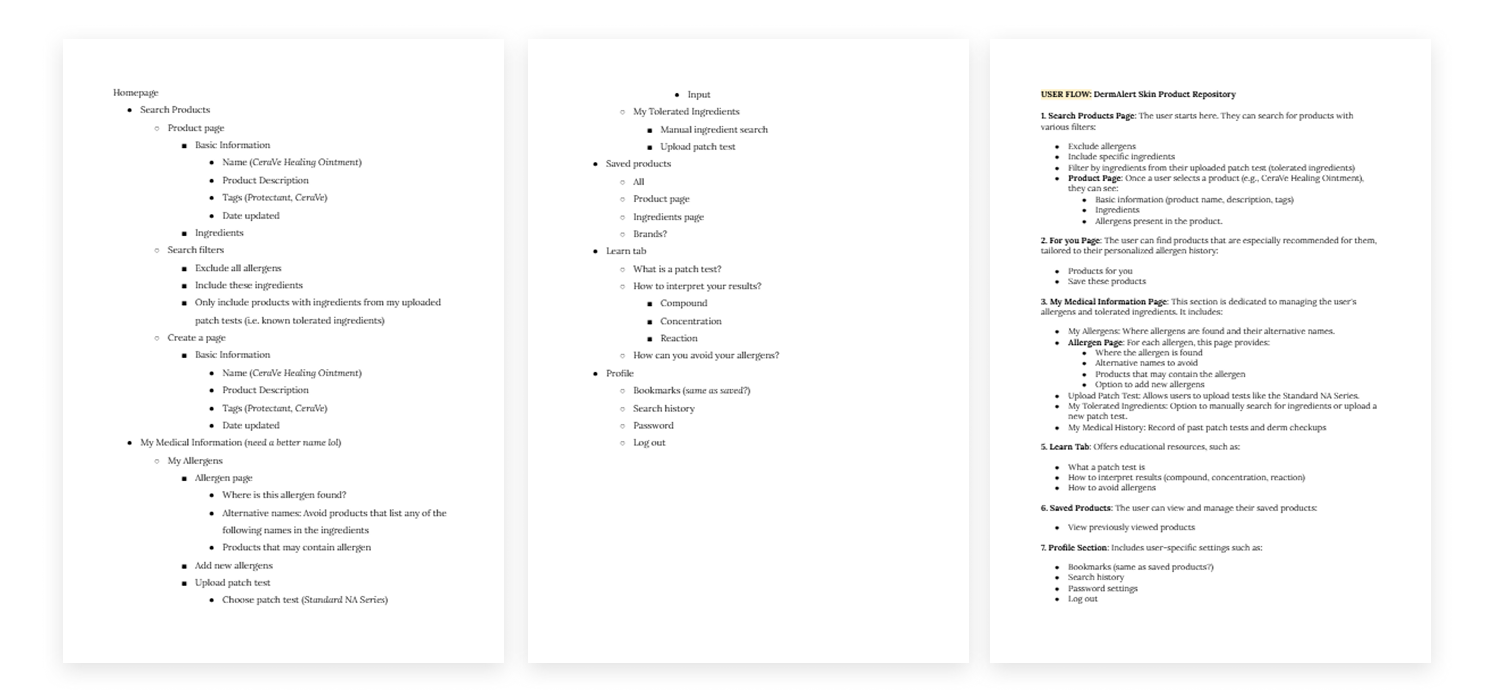
I created wireframes working off of my concepts from the ideation stage, where I played around with layout and functionality—experimenting with which features afforded users the greatest accessibility and ease of use. Below are some examples of my low-fidelity wireframes.
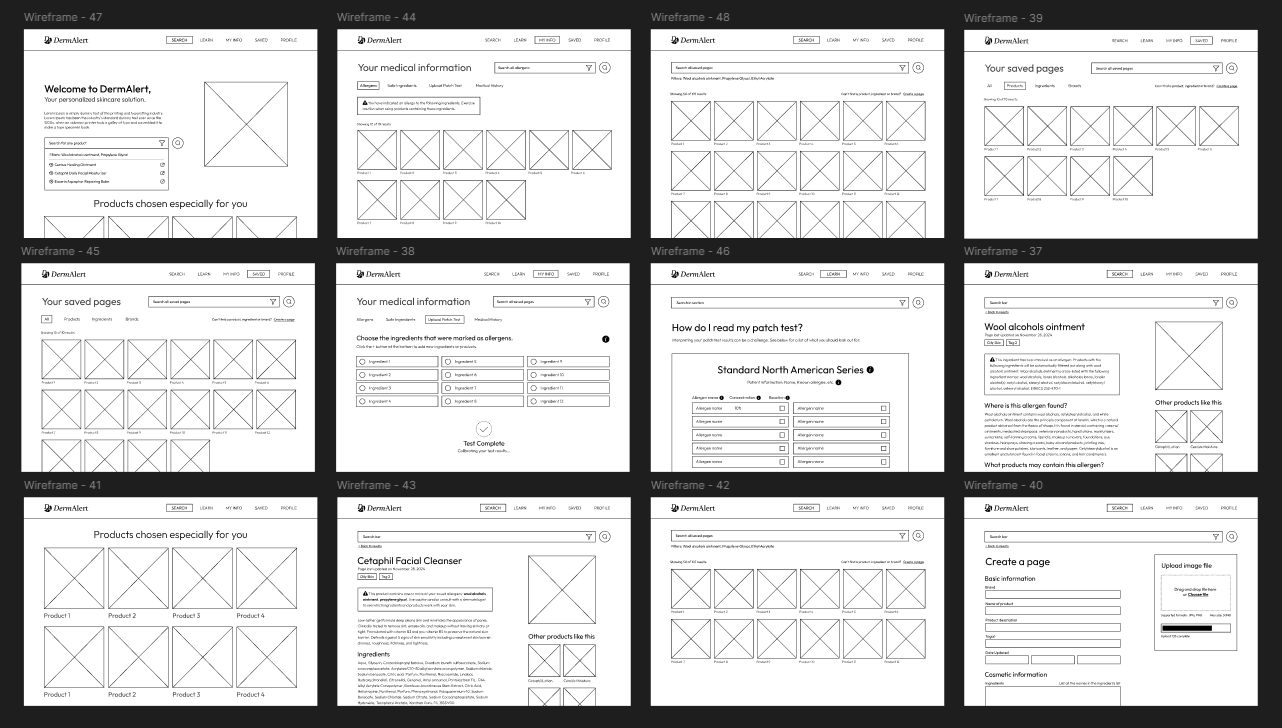
While the visual design stage is still in its infancy and subject to changes, I based many design decisions on user research and feedback. I consulted with a handful of my interviewees about the visuals and gathered some important findings, including:
- Orange was the preferred colour choice of almost all surveyed, with users deeming blue too clinical, while green, red, and purple did not seem to fit the aesthetic of the brand.
- Sans-serif for body text made the website more readable, though users liked keeping some serif text for emphasis (originally, everything was serif, though this was quickly changed after user feedback).
A free, community-based online repository of skincare products and their ingredient lists that allows users to filter out their specific allergens and triggers.
Problem 1: The names of allergens on patch tests rarely match their names on ingredient lists.
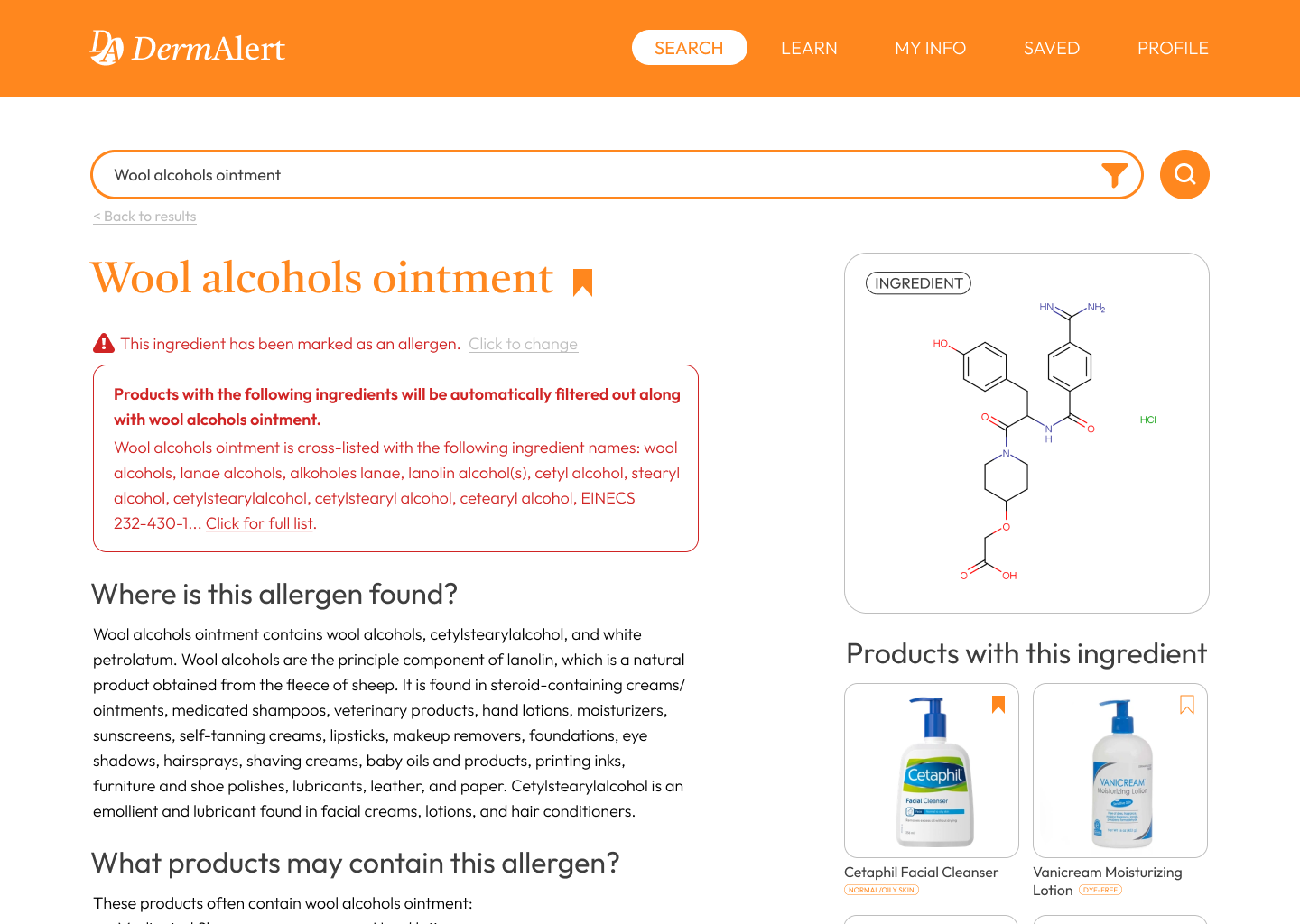
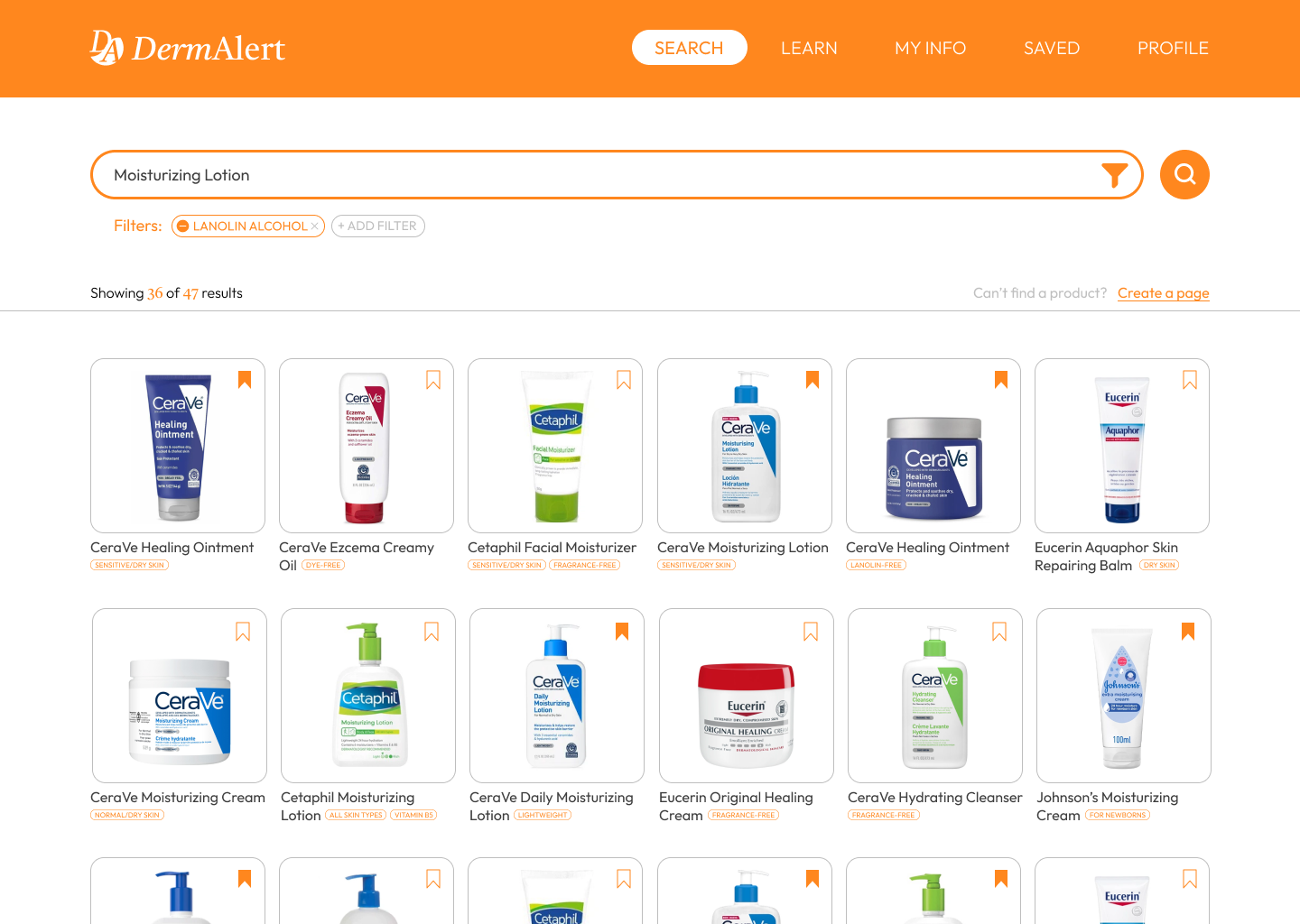
Solution 1: Search result filters will factor in ingredients that appear in different names on product lists.
- DermAlert will automatically add cross-listed keywords to the filter algorithm, without having the responsibility fall on the user to research and type all the different names of an ingredient to filter them out (of which they will almost surely miss some).
- Each ingredient/allergen will have a dedicated informational page with a list of alternative names so users will know what to look out for on ingredient lists when shopping for products.
Problem 2: Current platforms require users to manually type in names of ingredients to filter out.

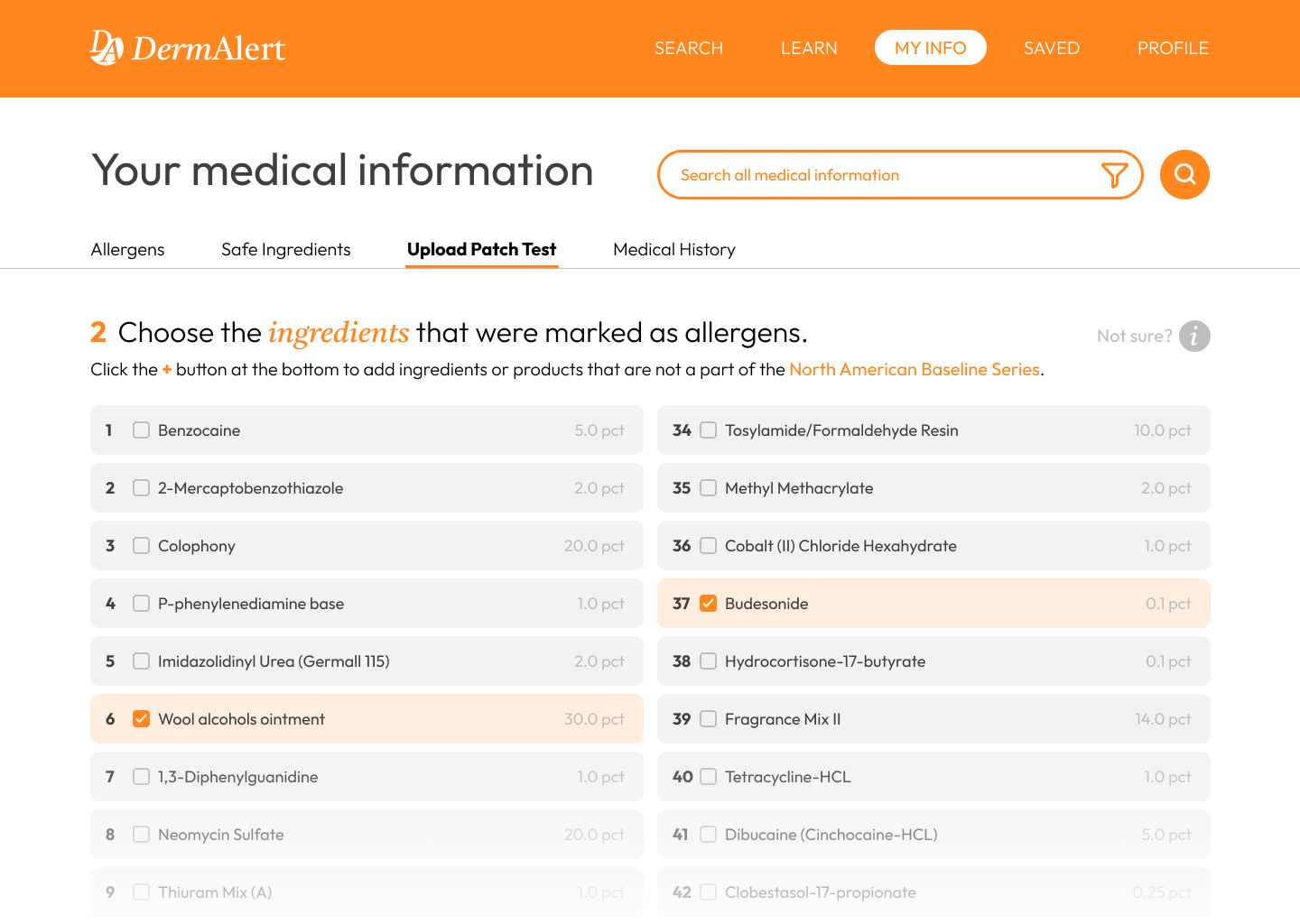
Solution 2: Users can automatically sort out what ingredients to filter out by uploading their patch test results.
- DermAlert uses a streamlined process of easy-to-follow questions for users to input their patch test information.
- Users will select multiple choice inputs rather than manually typing in their allergens, optimizing ease of use.
- Users choose the test used by their dermatologist (of which there are 33 standardized series), and proceed to check off the ingredients marked as allergens on their patch tests.
Problem 3: Other platforms don’t have a comprehensive inventory of products, especially non-cosmetic products.
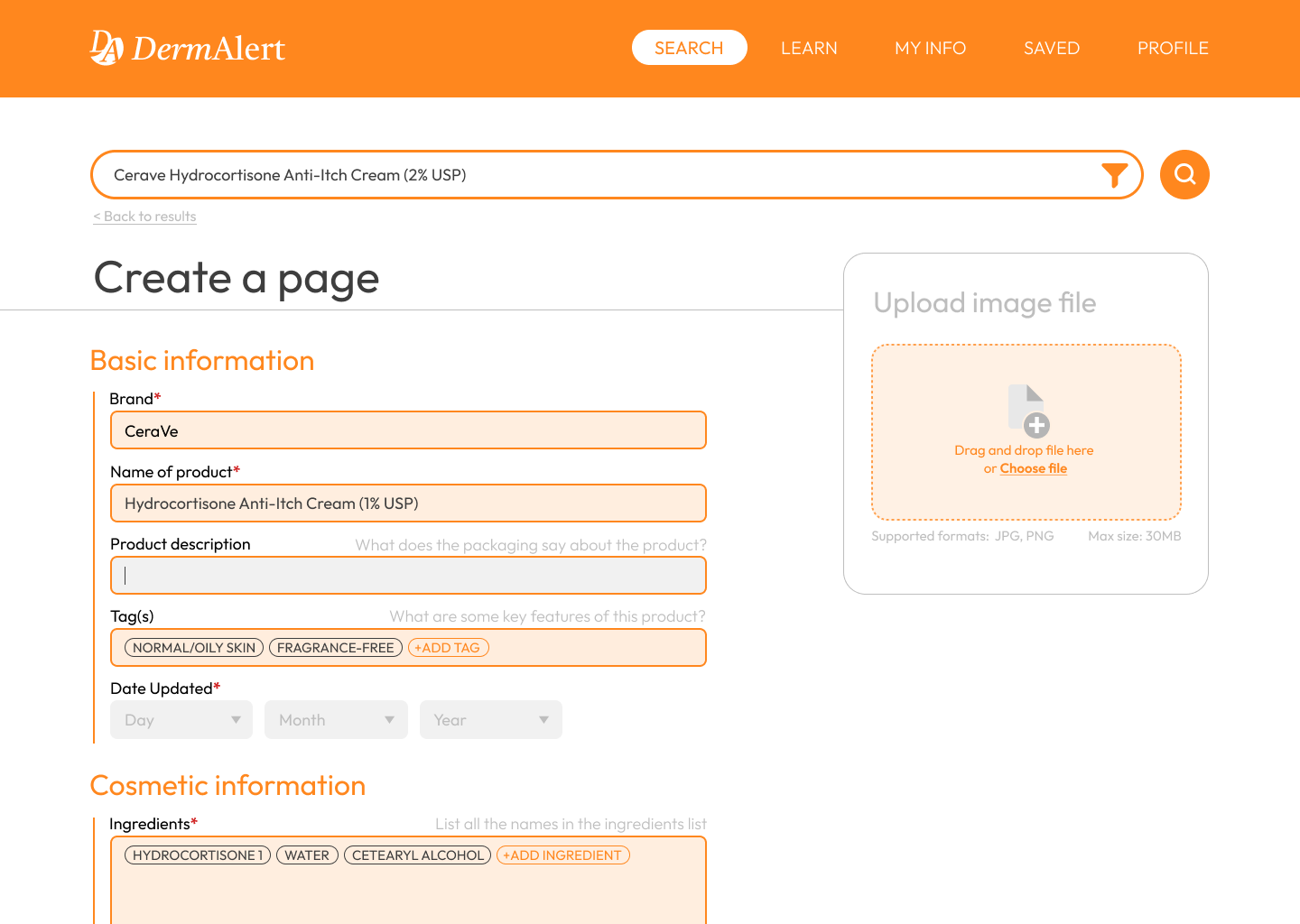

Solution 3: DermAlert will utilize a community-based model, allowing users to submit their own pages.
- At launch, DermAlert will include products/ingredient lists from the most common cosmetic and non-cosmetic products, including topical medications, sunscreen, and insect repellent.
- Users can and will be encouraged to request/create pages for products they cannot find to widen the scope of products available.
- New pages will undergo a community verification process and/or dermatologist review to ensure accuracy.
The three goals of the DermAlert project are to:
- Simplify the process of selecting skincare products, reducing the trial-and-error approach that often leads to flareups in patients with skin sensitivities.
- Provide a reliable resource that patients can refer to after receiving their patch test results, allowing them to avoid allergens with ease.
- Gather a sufficient user base to maintain a comprehensive database of skincare products and their ingredients that is up-to-date and accessible to users.
With DermAlert, I hope to empower individuals to make informed skincare choices, reducing reactions and improving skin health. Some long-term impacts of this resource may be:
- Increasing transparency among patients regarding skincare products, providing users with clear information about product ingredients and potential allergens.
- Improving patient outcomes and adherence to skin health plans after patch tests.
- Establishing a resource dermatologists feel confident recommending to patients.
- Best practices in science communication. ASCB. (2020, July 20).
- Brown, J. L., & Ruiz, C. E. (2016). Enhancing patient education following patch testing for allergic contact dermatitis. International Journal of Dermatology, 55(7), 761-767.
- Chia, W. R., & Wong, D. A. (2014). Patients' satisfaction and outcomes with patch testing for allergic contact dermatitis: A cohort study. Clinical Dermatology, 32(4), 500-507.
- Garg V, Brod B, Gaspari AA. Patch testing: Uses, systems, risks/benefits, and its role in managing the patient with contact dermatitis. Clin Dermatol. 2021 Jul-Aug;39(4):580-590.
- Heddle, R., & Swenor, P. M. (2015). Patients' perceptions of the usefulness and outcome of patch testing. Contact Dermatitis, 72(3), 169-175.
- Johnson, B. M., & Thompson, R. S. (2017). The role of patch testing in managing contact dermatitis: A review of methods and techniques. Dermatitis, 28(6), 450-459.
- Martin, D. M., & Hart, J. A. (2020). Impact on quality of life of an intervention providing additional information to patients with allergic contact dermatitis: A randomized clinical trial. Journal of Dermatological Treatment, 31(4), 356-362.
- McDonagh, A. J., & Norris, P. D. (2012). Psychological aspects of allergic contact dermatitis: Patients' perceptions and quality of life. Journal of the American Academy of Dermatology, 66(5), 845-852.
- Steuer MS, Botto NC. Patient Reported Improvement After Patch Testing and Allergen Avoidance Counseling: A Retrospective Analysis. Dermatol Ther (Heidelb). 2018 Sep;8(3):435-440.
